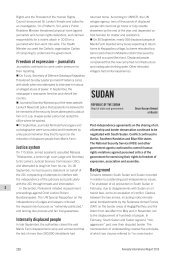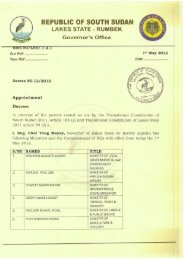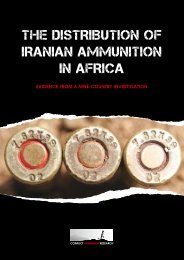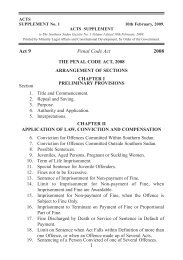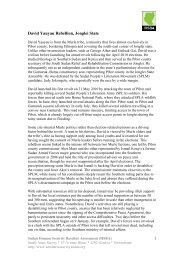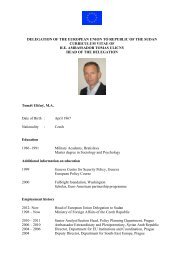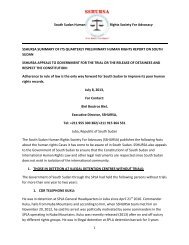THE SUDANESE HUMAN RIGHTS QUARTERLY - Sudan Tribune
THE SUDANESE HUMAN RIGHTS QUARTERLY - Sudan Tribune
THE SUDANESE HUMAN RIGHTS QUARTERLY - Sudan Tribune
You also want an ePaper? Increase the reach of your titles
YUMPU automatically turns print PDFs into web optimized ePapers that Google loves.
farmers would be forced to maintain the unity of their extended families,in compliance with religious orientations, and to sell the land or to continuefarming its small size. It is worthy of mention to say, that the averagesize of a farmer’s family is composed of 10 members who need educationaland health services, in addition to housing and the other basicneeds. And yet, a farmer’s annual average income doesn’t exceed183,000 <strong>Sudan</strong>ese pounds (SL1000=about US$183).The Act stipulates bank-land pawningThe Gazira Act 2005 stipulates the appropriation of hawashat by farmersaccording to these terms:A) “Individual ownership” for the farmers who already owned land.These farmers will continue owning the hawashat {i.e., the cultivatedfarms). But the remaining land under their possession will be dispossessedand immediately owned by the Government of <strong>Sudan</strong>, providedthat the owners will be fairly compensated. A major question, however,pertains to the “fair compensation” in legal, customary, and religiousterms. Who is going to take up this task? Would the prices be flexible?Or would the prices be forced upon the owner farmers?The land lords asked for a compensatory rate similar to the “ajr almithl”formula applied in the case of the Merowe Dam settlement of theinundated lands, i.e., the price of a feddan (approximate hectare) wouldbe equal to 10 million <strong>Sudan</strong>ese pounds (US$10,000). This is hardly imaginable(894,744 hectares X 10 million pounds=8,947,440 millionpounds). Also, the farmers wanted the same rate applied with respect todue payments of rent for the last 40 years.Another complication is related to the location and registration of theowned lands. For example, a farmer who cultivates a hawasha at the Al-Nadyana space nearby the Al-Foqara village might as well own land atthe Abd al-Aziz quarter nearby the Al-Ekoara and Wad Al-Balal areas,far away from his cultivated hawasha).The Salvation Government estimated the price of land as a necessarystep before farmers would be dispossessed of the land, provided that theland price would be set “on the basis of the rain-fed area before it hadbeen settled” (recommendation by the Gazira Land Settlement, 2003).10<strong>THE</strong> <strong>SUDANESE</strong> <strong>HUMAN</strong> <strong>RIGHTS</strong> <strong>QUARTERLY</strong>An ad hoc publication issued by the <strong>Sudan</strong> Human Rights Organization - Cairo



